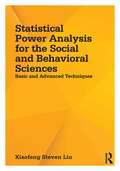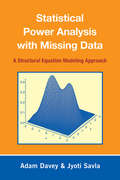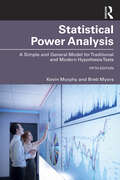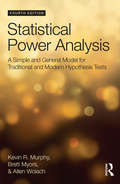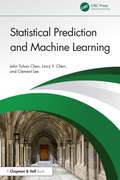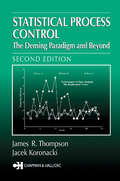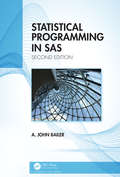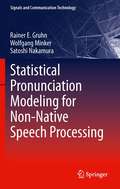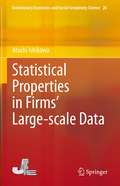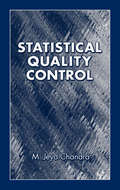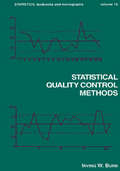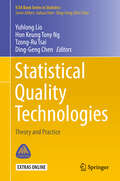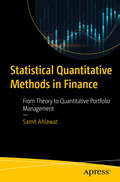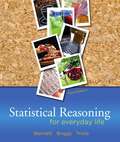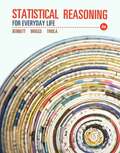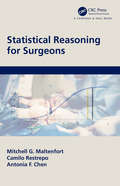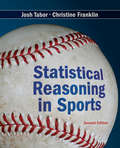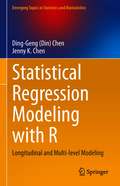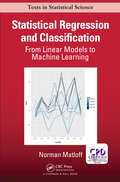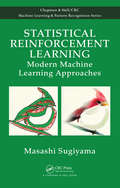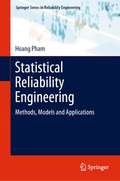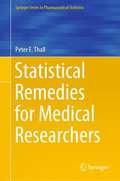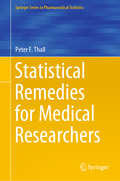- Table View
- List View
Statistical Power Analysis for the Social and Behavioral Sciences: Basic and Advanced Techniques
by Xiaofeng Steven LiuThis is the first book to demonstrate the application of power analysis to the newer more advanced statistical techniques that are increasingly used in the social and behavioral sciences. Both basic and advanced designs are covered. Readers are shown how to apply power analysis to techniques such as hierarchical linear modeling, meta-analysis, and structural equation modeling. Each chapter opens with a review of the statistical procedure and then proceeds to derive the power functions. This is followed by examples that demonstrate how to produce power tables and charts. The book clearly shows how to calculate power by providing open code for every design and procedure in R, SAS, and SPSS. Readers can verify the power computation using the computer programs on the book's website. There is a growing requirement to include power analysis to justify sample sizes in grant proposals. Most chapters are self-standing and can be read in any order without much disruption.This book will help readers do just that. Sample computer code in R, SPSS, and SAS at www.routledge.com/9781848729810 are written to tabulate power values and produce power curves that can be included in a grant proposal. Organized according to various techniques, chapters 1 – 3 introduce the basics of statistical power and sample size issues including the historical origin, hypothesis testing, and the use of statistical power in t tests and confidence intervals. Chapters 4 - 6 cover common statistical procedures -- analysis of variance, linear regression (both simple regression and multiple regression), correlation, analysis of covariance, and multivariate analysis. Chapters 7 - 11 review the new statistical procedures -- multi-level models, meta-analysis, structural equation models, and longitudinal studies. The appendixes contain a tutorial about R and show the statistical theory of power analysis. Intended as a supplement for graduate courses on quantitative methods, multivariate statistics, hierarchical linear modeling (HLM) and/or multilevel modeling and SEM taught in psychology, education, human development, nursing, and social and life sciences, this is the first text on statistical power for advanced procedures. Researchers and practitioners in these fields also appreciate the book‘s unique coverage of the use of statistical power analysis to determine sample size in planning a study. A prerequisite of basic through multivariate statistics is assumed.
Statistical Power Analysis with Missing Data: A Structural Equation Modeling Approach
by Adam Davey Jyoti "Tina" SavlaStatistical power analysis has revolutionized the ways in which we conduct and evaluate research. Similar developments in the statistical analysis of incomplete (missing) data are gaining more widespread applications. This volume brings statistical power and incomplete data together under a common framework, in a way that is readily accessible to those with only an introductory familiarity with structural equation modeling. It answers many practical questions such as: How missing data affects the statistical power in a study How much power is likely with different amounts and types of missing data How to increase the power of a design in the presence of missing data, and How to identify the most powerful design in the presence of missing data. Points of Reflection encourage readers to stop and test their understanding of the material. Try Me sections test one’s ability to apply the material. Troubleshooting Tips help to prevent commonly encountered problems. Exercises reinforce content and Additional Readings provide sources for delving more deeply into selected topics. Numerous examples demonstrate the book’s application to a variety of disciplines. Each issue is accompanied by its potential strengths and shortcomings and examples using a variety of software packages (SAS, SPSS, Stata, LISREL, AMOS, and MPlus). Syntax is provided using a single software program to promote continuity but in each case, parallel syntax using the other packages is presented in appendixes. Routines, data sets, syntax files, and links to student versions of software packages are found at www.psypress.com/davey. The worked examples in Part 2 also provide results from a wider set of estimated models. These tables, and accompanying syntax, can be used to estimate statistical power or required sample size for similar problems under a wide range of conditions. Class-tested at Temple, Virginia Tech, and Miami University of Ohio, this brief text is an ideal supplement for graduate courses in applied statistics, statistics II, intermediate or advanced statistics, experimental design, structural equation modeling, power analysis, and research methods taught in departments of psychology, human development, education, sociology, nursing, social work, gerontology and other social and health sciences. The book’s applied approach will also appeal to researchers in these areas. Sections covering Fundamentals, Applications, and Extensions are designed to take readers from first steps to mastery.
Statistical Power Analysis: A Simple and General Model for Traditional and Modern Hypothesis Tests, Fifth Edition
by Kevin R. Murphy Brett MyorsStatistical Power Analysis explains the key concepts in statistical power analysis and illustrates their application in both tests of traditional null hypotheses (that treatments or interventions have no effect in the population) and in tests of the minimum-effect hypotheses (that the population effects of treatments or interventions are so small that they can be safely treated as unimportant). It provides readers with the tools to understand and perform power analyses for virtually all the statistical methods used in the social and behavioral sciences. Brett Myors and Kevin Murphy apply the latest approaches of power analysis to both null hypothesis and minimum-effect testing using the same basic unified model. This book starts with a review of the key concepts that underly statistical power. It goes on to show how to perform and interpret power analyses, and the ways to use them to diagnose and plan research. We discuss the uses of power analysis in correlation and regression, in the analysis of experimental data, and in multilevel studies. This edition includes new material and new power software. The programs used for power analysis in this book have been re-written in R, a language that is widely used and freely available. The authors include R codes for all programs, and we have also provided a web-based app that allows users who are not comfortable with R to perform a wide range of analyses using any computer or device that provides access to the web. Statistical Power Analysis helps readers design studies, diagnose existing studies, and understand why hypothesis tests come out the way they do. The fifth edition includes updates to all chapters to accommodate the most current scholarship, as well as recalculations of all examples. This book is intended for graduate students and faculty in the behavioral and social sciences; researchers in other fields will find the concepts and methods laid out here valuable and applicable to studies in many domains.
Statistical Power Analysis: A Simple and General Model for Traditional and Modern Hypothesis Tests, Fourth Edition
by Kevin R. Murphy Brett Myors Allen WolachNoted for its accessible approach, this text applies the latest approaches of power analysis to both null hypothesis and minimum-effect testing using the same basic unified model. Through the use of a few simple procedures and examples, the authors show readers with little expertise in statistical analysis how to obtain the values needed to carry out the power analysis for their research. Illustrations of how these analyses work and how they can be used to choose the appropriate criterion for defining statistically significant outcomes are sprinkled throughout. The book presents a simple and general model for statistical power analysis based on the F statistic and reviews how to determine: the sample size needed to achieve desired levels of power; the level of power needed in a study; the size of effect that can be reliably detected by a study; and sensible criteria for statistical significance. The book helps readers design studies, diagnose existing studies, and understand why hypothesis tests come out out the way they do. The fourth edition features: -New Boxed Material sections provide examples of power analysis in action and discuss unique issues that arise as a result of applying power analyses in different designs. -Many more worked examples help readers apply the concepts presented. -Expanded coverage of power analysis for multifactor analysis of variance (ANOVA) to show readers how to analyze up to four factors with repeated measures on any or all of the factors. -Re-designed and expanded web based One Stop F Calculator software and data sets that allow users to perform all of the book's analyses and conduct significance tests, power analyses, and assessments of N and alpha needed for traditional and minimum-effects tests. -Easy to apply formulas for approximating the number of subjects required to reach adequate levels of power in a wide range of studies. Intended as a supplement for graduate/advanced undergraduate courses in research methods or experimental design, intermediate, advanced, or multivariate statistics, statistics II, or psychometrics, taught in psychology, education, business, and other social and health sciences, researchers also appreciate the book‘s applied approach.
Statistical Prediction and Machine Learning
by John Tuhao Chen Clement Lee Lincy Y. ChenWritten by an experienced statistics educator and two data scientists, this book unifies conventional statistical thinking and contemporary machine learning framework into a single overarching umbrella over data science. The book is designed to bridge the knowledge gap between conventional statistics and machine learning. It provides an accessible approach for readers with a basic statistics background to develop a mastery of machine learning. The book starts with elucidating examples in Chapter 1 and fundamentals on refined optimization in Chapter 2, which are followed by common supervised learning methods such as regressions, classification, support vector machines, tree algorithms, and range regressions. After a discussion on unsupervised learning methods, it includes a chapter on unsupervised learning and a chapter on statistical learning with data sequentially or simultaneously from multiple resources.One of the distinct features of this book is the comprehensive coverage of the topics in statistical learning and medical applications. It summarizes the authors’ teaching, research, and consulting experience in which they use data analytics. The illustrating examples and accompanying materials heavily emphasize understanding on data analysis, producing accurate interpretations, and discovering hidden assumptions associated with various methods.Key Features: Unifies conventional model-based framework and contemporary data-driven methods into a single overarching umbrella over data science. Includes real-life medical applications in hypertension, stroke, diabetes, thrombolysis, aspirin efficacy. Integrates statistical theory with machine learning algorithms. Includes potential methodological developments in data science.
Statistical Principles for the Design of Experiments
by R. Mead S. G. Gilmour A. MeadThis book is about the statistical principles behind the design of effective experiments and focuses on the practical needs of applied statisticians and experimenters engaged in design, implementation and analysis. Emphasising the logical principles of statistical design, rather than mathematical calculation, the authors demonstrate how all available information can be used to extract the clearest answers to many questions. The principles are illustrated with a wide range of examples drawn from real experiments in medicine, industry, agriculture and many experimental disciplines. Numerous exercises are given to help the reader practise techniques and to appreciate the difference that good design can make to an experimental research project. Based on Roger Mead's excellent Design of Experiments, this new edition is thoroughly revised and updated to include modern methods relevant to applications in industry, engineering and modern biology. It also contains seven new chapters on contemporary topics, including restricted randomisation and fractional replication.
Statistical Process Control For Quality Improvement- Hardcover Version
by J. Koronacki J.R. ThompsonThe first edition of this groundbreaking text showed that the Statistical Process Control (SPC) paradigm of W. Edwards Deming was not at all the same as the Quality Control paradigm that has dominated American manufacturing since World War II. Its philosophy of good management is rooted in a paradigm as process-oriented as physics, yet produces a friendly and fulfilling work environment. This second edition broadens its view to reveal even more of Deming's philosophy and provides more techniques for use at the managerial level. It shows readers that CEOs and service industries need SPC at least as much as production lines, and it offers precise methods and guidelines for their use.
Statistical Process Monitoring and Optimization (Statistics: A Series of Textbooks and Monographs)
by G. Geoffrey Vining Sung H. ParkDemonstrates ways to track industrial processes and performance, integrating related areas such as engineering process control, statistical reasoning in TQM, robust parameter design, control charts, multivariate process monitoring, capability indices, experimental design, empirical model building, and process optimization. The book covers a range o
Statistical Programming in SAS
by A. John BailerStatistical Programming in SAS Second Edition provides a foundation for programming to implement statistical solutions using SAS, a system that has been used to solve data analytic problems for more than 40 years. The author includes motivating examples to inspire readers to generate programming solutions. Upper-level undergraduates, beginning graduate students, and professionals involved in generating programming solutions for data-analytic problems will benefit from this book. The ideal background for a reader is some background in regression modeling and introductory experience with computer programming. The coverage of statistical programming in the second edition includes Getting data into the SAS system, engineering new features, and formatting variables Writing readable and well-documented code Structuring, implementing, and debugging programs that are well documented Creating solutions to novel problems Combining data sources, extracting parts of data sets, and reshaping data sets as needed for other analyses Generating general solutions using macros Customizing output Producing insight-inspiring data visualizations Parsing, processing, and analyzing text Programming solutions using matrices and connecting to R Processing text Programming with matrices Connecting SAS with R Covering topics that are part of both base and certification exams.
Statistical Pronunciation Modeling for Non-Native Speech Processing
by Wolfgang Minker Rainer E. Gruhn Satoshi NakamuraIn this work, the authors present a fully statistical approach to model non--native speakers' pronunciation. Second-language speakers pronounce words in multiple different ways compared to the native speakers. Those deviations, may it be phoneme substitutions, deletions or insertions, can be modelled automatically with the new method presented here. The methods is based on a discrete hidden Markov model as a word pronunciation model, initialized on a standard pronunciation dictionary. The implementation and functionality of the methodology has been proven and verified with a test set of non-native English in the regarding accent. The book is written for researchers with a professional interest in phonetics and automatic speech and speaker recognition.
Statistical Properties in Firms’ Large-scale Data (Evolutionary Economics and Social Complexity Science #26)
by Atushi IshikawaThis is the first book to provide a systematic description of statistical properties of large-scale financial data. Specifically, the power-law and log-normal distributions observed at a given time and their changes using time-reversal symmetry, quasi-time-reversal symmetry, Gibrat's law, and the non-Gibrat's property observed in a short-term period are derived here. The statistical properties observed over a long-term period, such as power-law and exponential growth, are also derived. These subjects have not been thoroughly discussed in the field of economics in the past, and this book is a compilation of the author's series of studies by reconstructing the data analyses published in 15 academic journals with new data. This book provides readers with a theoretical and empirical understanding of how the statistical properties observed in firms’ large-scale data are related along the time axis. It is possible to expand this discussion to understand theoretically and empirically how the statistical properties observed among differing large-scale financial data are related. This possibility provides readers with an approach to microfoundations, an important issue that has been studied in economics for many years.
Statistical Quality Control
by M. Jeya ChandraIt has recently become apparent that "quality" is quickly becoming the single most important factor for success and growth in business. Companies achieving higher quality in their products through effective quality improvement programs enjoy a significant competitive advantage. It is, therefore, essential for engineers responsible for design, devel
Statistical Quality Control Methods: Statistics: A Series of Textbooks and Monographs
by Irving W. BurrStatistical Quality Control Methods by Irving W. Burr.
Statistical Quality Technologies: Theory and Practice (ICSA Book Series in Statistics)
by Hon Keung Tony Ng Ding-Geng Chen Yuhlong Lio Tzong-Ru TsaiThis book explores different statistical quality technologies including recent advances and applications. Statistical process control, acceptance sample plans and reliability assessment are some of the essential statistical techniques in quality technologies to ensure high quality products and to reduce consumer and producer risks. Numerous statistical techniques and methodologies for quality control and improvement have been developed in recent years to help resolve current product quality issues in today’s fast changing environment. Featuring contributions from top experts in the field, this book covers three major topics: statistical process control, acceptance sampling plans, and reliability testing and designs. The topics covered in the book are timely and have a high potential impact and influence to academics, scholars, students and professionals in statistics, engineering, manufacturing and health.
Statistical Quantitative Methods in Finance: From Theory to Quantitative Portfolio Management
by Samit AhlawatStatistical quantitative methods are vital for financial valuation models and benchmarking machine learning models in finance. This book explores the theoretical foundations of statistical models, from ordinary least squares (OLS) to the generalized method of moments (GMM) used in econometrics. It enriches your understanding through practical examples drawn from applied finance, demonstrating the real-world applications of these concepts. Additionally, the book delves into non-linear methods and Bayesian approaches, which are becoming increasingly popular among practitioners thanks to advancements in computational resources. By mastering these topics, you will be equipped to build foundational models crucial for applied data science, a skill highly sought after by software engineering and asset management firms. The book also offers valuable insights into quantitative portfolio management, showcasing how traditional data science tools can be enhanced with machine learning models. These enhancements are illustrated through real-world examples from finance and econometrics, accompanied by Python code. This practical approach ensures that you can apply what you learn, gaining proficiency in the statsmodels library and becoming adept at designing, implementing, and calibrating your models. By understanding and applying these statistical models, you enhance your data science skills and effectively tackle financial challenges. What You Will Learn Understand the fundamentals of linear regression and its applications in financial data analysis and prediction Apply generalized linear models for handling various types of data distributions and enhancing model flexibility Gain insights into regime switching models to capture different market conditions and improve financial forecasting Benchmark machine learning models against traditional statistical methods to ensure robustness and reliability in financial applications Who This Book Is For Data scientists, machine learning engineers, finance professionals, and software engineers
Statistical Reasoning For Everyday Life
by Jeffrey O. Bennett William L. Briggs Mario F. TriolaIntended for social science students, this textbook explains the simple concepts of sampling, graphing, and distribution, then describes the role of probability, the interpretation of correlations, and methods for estimating population parameters and testing hypotheses. The second edition adds two sections on statistical paradoxes and hypothesis testing with two-way tables to the last chapter. Annotation c. Book News, Inc. , Portland, OR (booknews. com)
Statistical Reasoning For Everyday Life (Fourth Edition)
by Jeffrey O. Bennett William L. Briggs Mario F. Triola Bill F. BriggsStatistical Reasoning for Everyday Life, Fourth Edition, provides students with a clear understanding of statistical concepts and ideas so they can become better critical thinkers and decision makers, whether they decide to start a business, plan for their financial future, or just watch the news. The authors bring statistics to life by applying statistical concepts to the real world situations, taken from news sources, the internet, and individual experiences.
Statistical Reasoning for Surgeons
by Mitchell G. Maltenfort Camilo Restrepo Antonia F. ChenTrying to read up on statistics can be like trying to decide where you want to start eating the elephant and what’s the most digestible way to get it down. This book is written to give bite-size nuggets of insight based on our experiences grappling with datasets large and small. It is intended to bridge the gap between the formal equations and the practicalities of generating a research manuscript. We won’t pretend reading it will answer all your questions but it will help explain what questions need to be asked for your study and how you can address them with both accuracy and clarity. The size, detail and (ostensible) organization of this book allow for easy reading and can give a leg (or at least a half-step) up for those seeking more detailed study later. Features include: Excel sheets to allow exploration of topics raised Emphasis on intuitive explanations over formulas. Consideration of issues specific to clinical and surgical studies Our audience is someone who may or may not have enjoyed formal statistics education (that is, you may have had it and not enjoyed it!) who may like seeing a more dressed-down presentation of the topics. Actual statisticians may pick this up at risk of a chuckle (with us or at us) and may find some useful ways to present topics to non-statisticians.
Statistical Reasoning in Sports
by Christine Franklin Josh TaborStatistical Reasoning in Sports by Christine Franklin and Josh Tabor
Statistical Regression Modeling with R: Longitudinal and Multi-level Modeling (Emerging Topics in Statistics and Biostatistics)
by Ding-Geng (Din) Chen Jenny K. ChenThis book provides a concise point of reference for the most commonly used regression methods. It begins with linear and nonlinear regression for normally distributed data, logistic regression for binomially distributed data, and Poisson regression and negative-binomial regression for count data. It then progresses to these regression models that work with longitudinal and multi-level data structures. The volume is designed to guide the transition from classical to more advanced regression modeling, as well as to contribute to the rapid development of statistics and data science. With data and computing programs available to facilitate readers' learning experience, Statistical Regression Modeling promotes the applications of R in linear, nonlinear, longitudinal and multi-level regression. All included datasets, as well as the associated R program in packages nlme and lme4 for multi-level regression, are detailed in Appendix A. This book will be valuable in graduate courses on applied regression, as well as for practitioners and researchers in the fields of data science, statistical analytics, public health, and related fields.
Statistical Regression and Classification: From Linear Models to Machine Learning (Chapman & Hall/CRC Texts in Statistical Science)
by Norman Matloff<p>Statistical Regression and Classification: From Linear Models to Machine Learning takes an innovative look at the traditional statistical regression course, presenting a contemporary treatment in line with today's applications and users. <p>The book treats classical regression methods in an innovative, contemporary manner. Though some statistical learning methods are introduced, the primary methodology used is linear and generalized linear parametric models, covering both the Description and Prediction goals of regression methods. The author is just as interested in Description applications of regression, such as measuring the gender wage gap in Silicon Valley, as in forecasting tomorrow's demand for bike rentals. An entire chapter is devoted to measuring such effects, including discussion of Simpson's Paradox, multiple inference, and causation issues. Similarly, there is an entire chapter of parametric model fit, making use of both residual analysis and assessment via nonparametric analysis.</p>
Statistical Reinforcement Learning: Modern Machine Learning Approaches (Chapman & Hall/CRC Machine Learning & Pattern Recognition)
by Masashi SugiyamaReinforcement learning (RL) is a framework for decision making in unknown environments based on a large amount of data. Several practical RL applications for business intelligence, plant control, and gaming have been successfully explored in recent years. Providing an accessible introduction to the field, this book covers model-based and model-free approaches, policy iteration, and policy search methods. It presents illustrative examples and state-of-the-art results, including dimensionality reduction in RL and risk-sensitive RL. The book provides a bridge between RL and data mining and machine learning research.
Statistical Reliability Engineering: Methods, Models and Applications (Springer Series in Reliability Engineering)
by Hoang PhamThis book presents the state-of-the-art methodology and detailed analytical models and methods used to assess the reliability of complex systems and related applications in statistical reliability engineering. It is a textbook based mainly on the author’s recent research and publications as well as experience of over 30 years in this field. The book covers a wide range of methods and models in reliability, and their applications, including: statistical methods and model selection for machine learning; models for maintenance and software reliability; statistical reliability estimation of complex systems; and statistical reliability analysis of k out of n systems, standby systems and repairable systems. Offering numerous examples and solved problems within each chapter, this comprehensive text provides an introduction to reliability engineering graduate students, a reference for data scientists and reliability engineers, and a thorough guide for researchers and instructors in the field.
Statistical Remedies for Medical Researchers (Springer Series in Pharmaceutical Statistics)
by Peter F. ThallThis book illustrates numerous statistical practices that are commonly used by medical researchers, but which have severe flaws that may not be obvious. For each example, it provides one or more alternative statistical methods that avoid misleading or incorrect inferences being made. The technical level is kept to a minimum to make the book accessible to non-statisticians. At the same time, since many of the examples describe methods used routinely by medical statisticians with formal statistical training, the book appeals to a broad readership in the medical research community.
Statistical Remedies for Medical Researchers (Springer Series in Pharmaceutical Statistics)
by Peter F. ThallThis book illustrates numerous statistical practices that are commonly used by medical researchers, but which have severe flaws that may not be obvious. For each example, it provides one or more alternative statistical methods that avoid misleading or incorrect inferences being made. The technical level is kept to a minimum to make the book accessible to non-statisticians. At the same time, since many of the examples describe methods used routinely by medical statisticians with formal statistical training, the book appeals to a broad readership in the medical research community.
